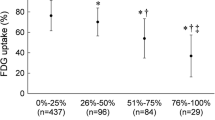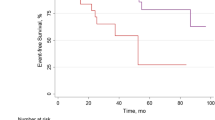Abstract
Objective
To analyze the relationship between the collateral flow of coronary chronic total occlusion (CTO) and myocardial viability detected by 18F-fluorodeoxyglucose (FDG) positron emission tomography/computed tomography (PET/CT) imaging.
Methods
A prospective analysis of 104 patients diagnosed by coronary angiography. All patients underwent resting myocardial perfusion imaging and PET/CT within 1 week. The collateral circulation was graded with Rentrop classification as no or poor collateral circulation in 16 CTO vessels, moderate collateral circulation in 34 CTO vessels, and good collateral circulation in 69 CTO vessels. Myocardial viability was determined with myocardial perfusion imaging and PET. The patterns were interpreted as mismatch, match and normal perfusion and 18F-FDG uptake.
Results
There was no significant correlation between the severity and extent of perfusion defect, myocardial viability and collateral circulation grade. The myocardial viability was normal in mild and moderate hypokinetic regions and decreased in severe hypokinetic and akinesis–dyskinesis regions. The presence of collateral circulation was a sensitive (89%) but not a specific (31%) sign of myocardial viability.
Conclusions
In patients with CTO, collateral circulation does not seem to be an effective way for predicting myocardial viability. Further analysis of PET patterns of viable myocardium is needed to guide further revascularization and predict functional improvement and survival benefit.





Similar content being viewed by others
References
Sianos G, Werner GS, Galassi AR, Papafaklis MI, Escaned J, Hildick-Smith D, et al. Recanalisation of chronic total coronary occlusions: 2012 consensus document from the Euro CTO club. EuroIntervention. 2012;8:139 – 45.
Fefer P, Knudtson ML, Cheema AN, Galbraith PD, Osherov AB, Yalonetsky S,et al. Current perspectives on coronary chronic total occlusions: the Canadian multicenter chronic total occlusions registry. J Am Coll Cardiol. 2012;59:991–7.
Jeroudi OM, Alomar ME, Michael TT, El Sabbagh A, Patel VG, Mogabgab O, et al. Prevalence and management of coronary chronic total occlusions in a tertiary veterans affairs hospital. Catheter Cardiovasc Interv. 2014;84:637–43.
Shah BN, Khattar RS, Senior R. The hibernating myocardium: current concepts, diagnostic dilemmas, and clinical challenges in the post-STICH era. Eur Heart J. 2013,34:1323–36.
Kolh P, Windecker S, Alfonso F, Collet JP, Cremer J, Falk V, et al. 2014 ESC/EACTS Guidelines on myocardial revascularization: the Task Force on Myocardial Revascularization of the European Society of Cardiology (ESC) and the European Association for Cardio-Thoracic Surgery (EACTS). Developed with the special contribution of the European Association of Percutaneous Cardiovascular Interventions (EAPCI).Eur. J Cardiothorac Surg. 2014;46:517–92.
Inaba Y, Chen JA, Bergmann SR. Quantity of viable myocardium required to improve survival with revascularization in patients with ischemic cardiomyopathy: a meta-analysis. J Nucl Cardiol, 2010;17:646–54.
Werner GS, Ferrari M, Heinke S, Kuethe F, Surber R, Richartz BM, et al. Angiographic assessment of collateral connections in comparison with invasively determined collateral function in chronic coronary occlusions. Circulation. 2003;107:1972–7.
Klocke FJ, Baird MG, Lorell BH, Bateman TM, Messer JV, Berman DS, et al. ACC/AHA/ASNC guidelines for the clinical use of cardiac radionuclide imaging–executive summary: a report of the American College of Cardiology/American Heart Association Task Force on Practice Guidelines (ACC/AHA/ASNC Committee to Revise the 1995 Guidelines for the Clinical Use of Cardiac Radionuclide Imaging. Circulation. 2003;108:1404–18.
Safley DM, Koshy S, Grantham JA, Bybee KA, House JA, Kennedy KF, et al. Changes in myocardial ischemic burden following percutaneous coronary intervention of chronic total occlusions. Catheter Cardiovasc Interv. 2011;78:337 – 43.
Judkins MP. Selective coronary arteriography. I. A percutaneous transfemoral technic. Radiology. 1967;89:815–24.
Rentrop KP, Cohen M, Blanke H, Phillips RA. Changes in collateral channel filling immediately after controlled coronary artery occlusion by an angioplasty balloon in human subjects. J Am Coll Cardiol. 1985;5:587–92.
Cerqueira MD, Weissman NJ, Dilsizian V, Jacobs AK, Kaul S, Laskey WK, et al. Standardized myocardial segmentation and nomenclature for tomographic imaging of the heart: a statement for healthcare professionals from the Cardiac Imaging Committee of the Council on Clinical. Cardiol Am Heart Assoc Circ. 2002;105:539–42.
Fukai M, Ii M, Nakakoji T, Kawakatsu M, Nariyama J, Yokota N, et al. Angiographically demonstrated coronary collaterals predict residual viable myocardium in patients with chronic myocardial infarction: a regional metabolic study. J Cardiol. 2000;35:103–11.
Suero JA, Marso SP, Jones PG, Laster SB, Huber KC, Giorgi LV, et al. Procedural outcomes and long-term survival among patients undergoing percutaneous coronary intervention of a chronic total occlusion in native coronary arteries: a 20-year experience. J Am Coll Cardiol. 2001;38:409–14.
Kumbasar D, Akyurek O, Dincer I, Atmaca Y, Kiliçkap M, Erol C,et al. Good collaterals predict viable myocardium. Angiology. 2007;58:550–5.
Kim RJ, Fieno DS, Parrish TB, Harris K, Chen EL, Simonetti O, et al. Relationship of MRI delayed contrast enhancement to irreversible injury, infarct age, and contractile function. Circulation. 1999;100:1992–2002.
Koszegi Z, Maes A, Piessens J, Van de Werf F, Mortelmans L. Segmental comparison between coronary angiography and positron emission tomography reveal slow predictive value of epicardial flow for viability. Eur Heart J. 1998;19:959–67.
Al-Mohammad A, Norton MY, Welch AE, Walton S. Characterization of viability, scarring and hibernation of the myocardium supplied by epicardial coronary arteries with low flow grades. Nucl Med Commun. 2017;38:657–65.
Di Carli M, Sherman T, Khanna S, Davidson M, Rokhsar S, Hawkins R,et al. Myocardial viability in asynergic regions subtended by occluded coronary arteries: relation to the status of collateral flow in patients with chronic coronary artery disease. J Am Coll Cardiol. 1994;23:860–8.
Seiler C. The human collateral coronary circulation. Eur J Clin Invest. 2010;40:465–76.
Arani DT, Greene DG, Bunnell IL, Smith GL, Klocke FJ. Reductions in coronary flow under resting conditions in collateral-dependent myocardium of patients with complete occlusion of the left anterior descending coronary artery. J Am Coll Cardiol. 1984;3:668–74.
Galassi AR, Werner GS, Tomasello SD, Azzarelli S, Capodanno D, Barrano G, et al. Prognostic value of exercise myocardial scintigraphy in patients with coronary chronic total occlusions. J Interv Cardiol. 2010;23:139–48.
Werner GS, Surber R, Ferrari M, Fritzenwanger M, Figulla HR. The functional reserve of collaterals supplying long-term chronic total coronary occlusions in patients without prior myocardial infarction. Eur Heart J. 2006;27:2406–2.
Aboul-Enein F, Kar S, Hayes SW, Sciammarella M, Abidov A, Makkar R,et al. Influence of angiographic collateral circulation on myocardial perfusion in patients with chronic total occlusion of a single coronary artery and no prior myocardial infarction. J Nucl Med. 2004;45:950–5.
Muehling O, Jerosch-Herold M, Cyran C, Huber A, Schoenberg S, Reiser M, et al. Assessment of collateralized myocardium with cardiac magnetic resonance (CMR): transmural extent of infarction but not angiographic collateral vessel filling determines regional function and perfusion in collateral-dependent myocardium. Int J Cardiol. 2007;120:38–44.
Vyssoulis G, Kyriakidis M, Karpanou E, Kyriakidis C, Sfikakis P, Barbetseas J, et al. A prospective angiographic study of the coronary collateral circulation in coronary arterial disease. Int J Cardiol. 1990;27:187 – 91.
Acknowledgements
We are grateful to Feng Wang for their excellent technical support. The work described here has not been submitted anywhere else for potential publication.
Funding
Capital Clinical Characteristics Application Study (Z161100000516139). Beijing LiSheng Cardiovascular Health Foundation Pilot Fund Project (LHJJ20158521).
Author information
Authors and Affiliations
Corresponding authors
Ethics declarations
Conflict of interest
No potential conflicts of interest were disclosed.
Rights and permissions
About this article
Cite this article
Dong, W., Li, J., Mi, H. et al. Relationship between collateral circulation and myocardial viability of 18F-FDG PET/CT subtended by chronic total occluded coronary arteries. Ann Nucl Med 32, 197–205 (2018). https://doi.org/10.1007/s12149-018-1234-3
Received:
Accepted:
Published:
Issue Date:
DOI: https://doi.org/10.1007/s12149-018-1234-3




